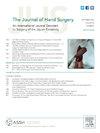翻修 A1 滑轮释放术:利用全国数据库分析风险因素。
IF 2.1
2区 医学
Q2 ORTHOPEDICS
引用次数: 0
摘要
目的:触发指松解术(TFR)是手外科常用的一种手术。扳机指松解术的成功率很高,但也有复发的可能。有关翻修 TFR(rTFR)的数据很少,与需要翻修手术相关的因素也鲜为人知。我们的目的是分析与 rTFR 手术相关的风险因素:利用国家数据库(PearlDiver 研究计划),使用当前程序术语和国际疾病分类 (ICD)-10 代码识别 2015 年至 2022 年期间接受 TFR 的患者。如果患者在出院当天或手术后两周内获得扳机指的 ICD-10 诊断,则被纳入其中。接受扳机指复位手术的患者是通过鉴定在指数手术后在同侧手的同一手指上完成的二次手术来确定的。记录了1年、3年和5年的翻修率。通过单变量和多变量逻辑回归分析对人口统计学和合并症进行分类研究:结果:TFR术后共有46613名患者符合纳入标准,其中1793人(3.85%)接受了翻修放疗。多变量分析表明,糖尿病、缺血性心脏病和男性与初次手术后 1、3 和 5 年内接受翻修手术的几率明显增加有关。年龄大于 65 岁和高血压与 3 年和 5 年翻修手术几率增加有关,而腕管综合征仅是 1 年和 3 年翻修手术的风险因素。甲状腺功能减退症与所有时间点的翻修率降低有关,仅在5年时吸烟与翻修率降低有关:这些数据表明,男性、糖尿病和心脏病是短期和中期内需要进行TFR翻修的风险因素。研究类型/证据级别:预后 II:预后 II。本文章由计算机程序翻译,如有差异,请以英文原文为准。
Revision A1 Pulley Release: An Analysis of Risk Factors Using a National Database
Purpose
Trigger finger release (TFR) is a commonly performed procedure in hand surgery. Trigger finger release has a high success rate, but recurrence can occur. Data on revision TFR (rTFR) are sparse, with little known regarding factors associated with the need for revision surgery. Our purpose was to analyze risk factors associated with rTFR procedures.
Methods
Using a national database (PearlDiver Research Program), patients who underwent TFR between 2015 and 2022 were identified using Current Procedural Terminology and International Classification of Diseases (ICD)-10 codes. Patients were included if they received an ICD-10 diagnosis of trigger finger on the same day as their release or within 2 weeks of their procedure. Patients who underwent rTFR were determined through identification of a secondary procedure completed in the same digit on the ipsilateral hand performed after the index procedure. Revision rates at 1, 3, and 5 years were recorded. Demographics and comorbidities were categorically examined via univariate and multivariable logistic regression analyses.
Results
A total of 46,613 patients meeting inclusion criteria were identified after TFR with 1,793 (3.85%) undergoing revision release. Multivariable analysis demonstrated that diabetes, ischemic heart disease, and male sex were associated with statistically significantly increased odds of revision procedures at 1, 3, and 5 years from the initial operation. Age >65 years and hypertension were associated with an increased odds of revision surgery at 3 and 5 years, and carpal tunnel syndrome as a risk factor at 1 and 3 years only. Hypothyroidism was associated with a decreased revision rate at all time points and tobacco use at 5 years only.
Conclusions
These data demonstrate that male sex, diabetes, and heart disease are risk factors for requiring revision TFR in the short and medium terms. This information can add to preoperative counseling with patients undergoing surgical treatment of trigger digits.
Type of study/level of evidence
Prognostic II.
求助全文
通过发布文献求助,成功后即可免费获取论文全文。
去求助
来源期刊
CiteScore
3.20
自引率
10.50%
发文量
402
审稿时长
12 weeks
期刊介绍:
The Journal of Hand Surgery publishes original, peer-reviewed articles related to the pathophysiology, diagnosis, and treatment of diseases and conditions of the upper extremity; these include both clinical and basic science studies, along with case reports. Special features include Review Articles (including Current Concepts and The Hand Surgery Landscape), Reviews of Books and Media, and Letters to the Editor.

 求助内容:
求助内容: 应助结果提醒方式:
应助结果提醒方式:


